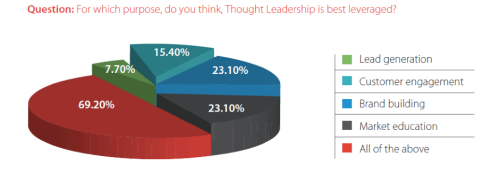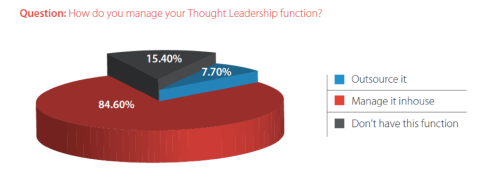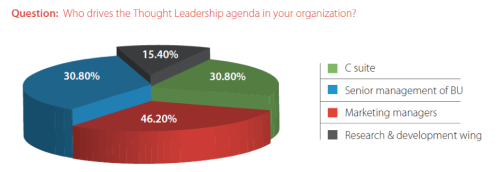An assessment of businesses’ adoption and execution of the thought leadership function.
Introduction
Thought Starters conducted a survey that included CXOs, EVPs and Marketing managers from companies across Americas, Europe, Middle East and Asia Pacific to map thought leadership marketing function within organizations. The participants represent a range of industries including IT, ITES, retail, financial services and healthcare. While not a comprehensive picture of how organizations from various industry segments are currently addressing their thought leadership marketing function, the survey findings point to some general trends around the same and indicate the direction companies need to take in the near future.
Abstract
While organizations around the world have recognized thought leadership as a major competitive differentiator, few understand how to best implement this function. The findings of this survey suggest that organizations are still struggling to showcase their ‘thought capital’ in the best possible manner. While many organizations incorrectly equate thought leadership with content marketing, they also underestimate the efforts required to make this function succeed.
Organizations must recognize thought leadership as a long term strategy to define and differentiate their organization, and which must be driven by the top management. Organizations must honestly assess their capability to drive this function and be open to expert intervention to maximize impact.
The Findings of the Survey
In a brutally competitive business environment, one must come out with all guns blazing. Simply put, you cannot be assured of good returns just because you have a superb product or service. Marketing helps, but in the deluge of traditional marketing activities, how do you get yourself heard? It is time to look beyond annual plans & reports and address the big picture. Thought leadership marketing, if executed well, can be the answer to these questions by proving to be an unparalleled competitive differentiator.
Thought Starters conducted an online survey to understand the state of thought leadership marketing function. The intention of the survey was not only to check if organizations recognize the need for thought leadership marketing function, but how they managed this particular function, who the key stakeholders are, and what the chief drivers are. The survey, in combination with known statistics about this function, revealed several noteworthy insights.
Most organizations recognize the challenge of differentiating themselves successfully in a crowded marketplace since a whopping 82% of marketers intend to increase their focus on content and thought leadership marketing. Interestingly, most organizations are still managing this vital function in-house, even though only 5% of B2B buyers believe that marketers are showcasing their thought leadership effectively. This finding points at the large gap in understanding and fulfilling the requirements of the thought leadership function.
Thought Starters conducted a market survey that revealed several important insights.
Existence of an exclusive thought leadership marketing function in organizations:

A majority of respondents admitted that they did not have an exclusive thought leadership marketing function in their organization. Only around a third or 38.5% of respondents precisely, claimed to have made some headway towards this direction. While it is true that thought leadership cannot be claimed but must be earned, it should be equally unacceptable for businesses to sit on a ‘big idea’ or not do justice to it by not promoting and nurturing it appropriately. Hence, organizations need to ask themselves if they are leveraging their thought leadership sufficiently.
More importantly, they need to ask themselves if they have the requisite skills and know-how to drive the thought leadership function. Often, it is better to bring in experts who can maximize the reach and impact of the function within a stipulated timeframe. After all, the power of a thought leadership drive gone bad, must not be under-estimated since it can have serious repercussions on the organization.
The purpose for which thought leadership is best leveraged:

The majority of respondents, i.e. 69.20%, felt that thought leadership is best leveraged for all the options listed, namely: lead generation, customer engagement, brand building and market education. While 23.10% of the respondents felt that thought leadership equally aided brand building and market education, 15.4% felt that it accelerated customer engagement. Only 7.70% of the respondents felt that thought leadership aided lead generation. While it is true that thought leadership shapes the big picture, our research has revealed that it does so through market education, brand building as a trusted advisor and partner, and engaging the audience in the entire process.
The survey also highlighted the tendency for businesses to see thought leadership as a short term strategy to create whitepapers and elicit leads. This, at best, can be one of the bonuses of the thought leadership function, but certainly isn’t the motive. Thought leadership is a long term strategy that defines the heart of any organization. As opposed to the rest of the marketing strategies that ‘push’ the target audience, thought leadership function ‘pulls’ them by giving away actionable knowledge. Sharing knowledge, without pitching one’s own services and products, not only establishes expertise, but generates trust – the biggest incentive to forge a business deal.
However, the thought leadership function requires fine orchestration. While the core of the function is certainly defined by the one’s own inherent expertise or unique idea, its demonstration requires committed investment of time, effort and money, in addition to having the right strategy in place.
How the thought leadership function is managed:

A whopping 84.60% of respondents claimed that they managed the thought leadership function in-house. While 15.40% of respondents did not have this function, only 7.70% have outsourced it. However, with just 5% satisfied B2B buyers, the glaring gap between the demand for effective thought leadership marketing and the inability of the majority of businesses to satisfy their audience in this context, is loud and clear.
The finding also indicates the tendency to equate thought leadership with content marketing. Businesses must realize that content is just one of the mediums through which thought leadership is demonstrated. In fact, the thought leadership function spreads much beyond content and includes steps such as creating the right solutions, engaging with key influencers and converting them into brand ambassadors, and creating platforms that can showcase the organization’s expertise more effectively.
These targets can seldom be achieved with in-house talent. Hence there is a clear need to engage the right partners to manage the thought leadership function. Moreover, businesses should consider outsourcing the function in order to maintain lean processes and control expenditure.
The chief driver of thought leadership agenda in organizations:

In the majority of organizations, it is the marketing managers who call the shots regarding thought leadership marketing function. While 46.20% of respondents chose marketing managers as their answer, senior management of business units came a close second with 38.50% votes. The C-suite came in third with 30.80 votes while the research and development (R&D) wing could garner just 15.40 votes.
The voting pattern clearly shows that as of now, marketing drives thought leadership function. This may be good from an outreach perspective. However, for creating a culture of thought leadership and innovating in this regard, the R&D wing needs to work in close association with the C suite. Marketing teams can then leverage expert agencies who can help them showcase their thought leadership better, gain better mind share and therefore grab a bigger market share.
Summary
Beyond doubt, thought leadership marketing is gaining in importance. Already, half of the businesses use thought leadership marketing for market education and showcasing expertise, and 82% of marketers intend to increase their focus on content and thought leadership marketing. The investment in thought leadership marketing is likely to double its value from 2013 to 2016. The message on the wall is clear: thought leadership marketing should be at the core of the company’s strategy.
However, most organizations are under-equipped to deal with the challenges presented by thought leadership marketing. Thought leadership should be treated as an organization’s DNA. Therefore all the other policies, including branding and communication strategies, must be realigned to compliment the core objective of establishing the organization’s thought leadership. Even though most companies recognize the need to have a separate thought leadership function, few have implemented it. Moreover, a core function such as this should ideally be driven by the C-suite in association with the R&D wing & marketing teams. But currently it is primarily in the hands of Marketing Managers. This disables the intent of thought leadership by reducing it to a short term strategy. Most importantly, despite the gaps in demand for thought leadership marketing and its effectiveness, organizations continue to manage it in-house.
The findings clearly suggest that thought leadership requires buy-in of the senior management and expert intervention that is not available in-house. This would help businesses achieve the desired impact through appropriate platforms, collaborations and communication strategies and help strengthen their trust quotient.
 Written by Karthik Nagendra, Founder & Director of ThoughtLeaders. With more than a decade of core marketing experience with prime focus on brand positioning, communication strategy, executive communication & thought leadership marketing, Karthik & his team help businesses transform from sellers to influencers by helping them unearth their 'big idea' and thus brand them as experts in their field. He has authored papers & articles on thought leadership marketing in international journals & has been a guest speaker at the Wharton Business School, UCLA, Duke University among other Ivy league Universities globally.
Written by Karthik Nagendra, Founder & Director of ThoughtLeaders. With more than a decade of core marketing experience with prime focus on brand positioning, communication strategy, executive communication & thought leadership marketing, Karthik & his team help businesses transform from sellers to influencers by helping them unearth their 'big idea' and thus brand them as experts in their field. He has authored papers & articles on thought leadership marketing in international journals & has been a guest speaker at the Wharton Business School, UCLA, Duke University among other Ivy league Universities globally.